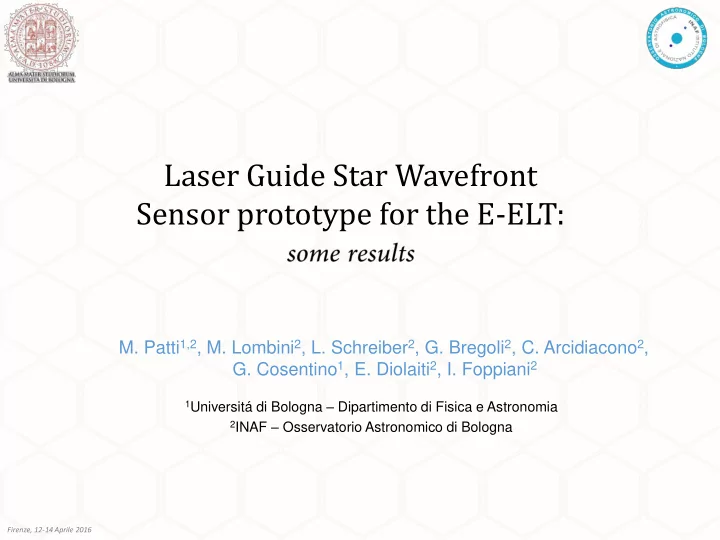

Laser Guide Star Wavefront Sensor prototype for the E-ELT: M. Patti 1,2 , M. Lombini 2 , L. Schreiber 2 , G. Bregoli 2 , C. Arcidiacono 2 , G. Cosentino 1 , E. Diolaiti 2 , I. Foppiani 2 1 Universitá di Bologna – Dipartimento di Fisica e Astronomia 2 INAF – Osservatorio Astronomico di Bologna Firenze, 12-14 Aprile 2016
Main objectives – Verify performance of LGS Shack Hartmann WFS under different working conditions (sampling, field of view, signal-to-noise ratio, algorithm type, Sodium profile features) – Study low/medium order aberrations induced by Sodium layer coupled with spot truncation and other effects in the LGS WFS – Verify the fidelity of numerical simulations that model the LGS image in the Shack Hartmann WFS sub-apertures Firenze, 12-14 Aprile 2016
Prototype scale LGS ‘seeing Considering Prototype configuration 1,5’’ 1.8 limited size’ pixels FWHM Pixel scale 0.83”/pixel max FoV per 19.9” Subaperture 15 𝑓 − RON Firenze, 12-14 Aprile 2016
Firenze, 12-14 Aprile 2016
Sandrine J. Thomas, Donald Gavel, and Robert Kibrick, "Analysis of on-sky sodium profile data from Lick Observatory," Appl. Opt. 49, 394-402 (2010) Most elongated sub-aperture : resolves Sodium profile intensity variations when Δ H > 2km Firenze, 12-14 Aprile 2016
1) Chose Sodium density profile 2) Associate SLM pixels to layer altitudes according to perspective elongation 3) Calibrate by SLM curve response Firenze, 12-14 Aprile 2016
Perform first set of tests with realistic static Sodium density profiles LGS NGS reference Reference LGS Truncation low/medium order aberration NGS LGS Difference Difference NGS LGS Turbulence Turbulence Plus Plus LGS Profile + Truncation low/medium order aberration Firenze, 12-14 Aprile 2016
𝑠 𝑝 ≅ 20𝑑𝑛 Firenze, 12-14 Aprile 2016
𝑠 𝑝 ≅ 3 𝑛 Firenze, 12-14 Aprile 2016
Test the idea to use the most elongated sub-aperture as a Sodium profile monitor. Such an ‘in situ’ tool could : • prevent spurious aberrations, especially if a large spot truncation is foreseen. • provide relevant sodium layer statistics that should correlate in a direct way with AO system performance at the telescope. Firenze, 12-14 Aprile 2016
Firenze, 12-14 Aprile 2016
Firenze, 12-14 Aprile 2016
Firenze, 12-14 Aprile 2016
Plus Firenze, 12-14 Aprile 2016
Conclusion – .Strong turbulence. When the AO loop starts, the low/medium order aberrations due to LGS image truncation and/or Sodium density variability are not significant . – .Weak turbulence. Close to the AO loop convergence, LGS image truncation and/or Sodium density variability influence the WFS performance – .Sodium monitor. Useful to mitigate the wavefront sensing risks but not sufficient to avoid a reference WFS, based on NGS, to measure the LGS spurious aberrations – .Near future. Use the prototype to test the performance of Quad-cell (binning the detector) and Pyramid WFS (new optical channel) Firenze, 12-14 Aprile 2016
Recommend
More recommend